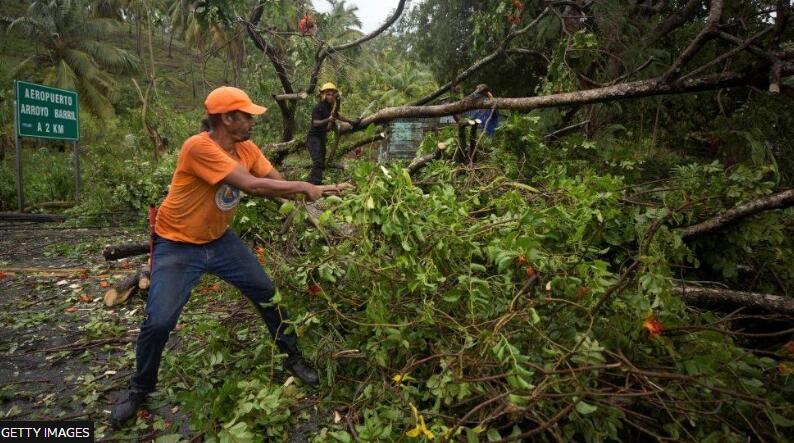Hurricane Fiona: Dominican Republic hit as storm strengthens
Forecasters say the category three storm, with wind speeds of 115mph (185km/h), could worsen to a category four – the second-highest designation.
Rain has been lashing Puerto Rico, where at least four people died and 80% of the island remains without power.
Two deaths have also been reported in the Dominican Republic.
An 18-year-old girl passed away after being struck by an electric pole felled by strong winds, while a man in the north-eastern town of Nagua was killed by a falling tree.
President Luis Abinader has declared three eastern provinces of the Dominican Republic to be disaster zones, amid warnings from the NHC of “heavy rainfall and life-threatening flash flooding”.
The hurricane slammed into Grand Turk Island in the Turks and Caicos Islands on Tuesday morning local time, the US National Hurricane Center (NHC) said.
No fatalities or serious injuries were reported there but residents were advised to continue sheltering in place as blackouts and flooding caused by heavy rain continued into the afternoon.
Several villages were cut off in the country as floodwaters rose, while hundreds of people were forced to leave their homes and thousands were left without power.
Lexie Wilcox, who lives in the easternmost province of Altagracia, said it was the worst hurricane she had experienced and had hit her local area much harder than Hurricane Maria in 2017, which killed nearly 3,000 people in neighbouring Puerto Rico.
On Monday morning there were trees down, with roads blocked and a lot of flooding.
Ms Wilcox said she was unable to sleep, spending the night mopping up rainwater.
She and her neighbours are without electricity, and believe this may take days to be fixed as the storm is ongoing.
Connection returned for a few minutes on Monday, just long enough to allow Ms Wilcox, who is Canadian, to watch the end of Queen Elizabeth II’s funeral while the hurricane raged outside.
The NHC warned earlier of “catastrophic flooding”. Fiona made landfall there on Sunday, causing not only deluges, but widespread landslides and mudslides.
The storm caused an island-wide blackout that providers warned could take days to fix.
Puerto Rico’s electricity grid remains fragile after the island was devastated five years ago by Hurricane Maria – the most powerful storm in its history.
An estimated 1.3 million homes and businesses in Puerto Rico are currently without power, Reuters news agency reports.
Power provider LUMA Energy said it had restored services to more than 100,000 customers and its staff were working to bring back power for others. The company said “full restoration could take several days”.
Ramon Luis Nieves, a lawyer in the capital San Juan who was without power in his home, told Reuters his experience had been “horrible” after Hurricane Maria. “They promised it would be better. It hasn’t,” he said.
Some areas of the island face the prospect of 35in (89cm) of rainfall as the storm passes.
US President Joe Biden pledged to scale up support for the US territory following a conversation with the governor.
The victims in Puerto Rico were a 58-year-old man who died after being swept away by a river, while another in his 70s died in a generator fire.
One death was also recorded on the French island of Guadeloupe.
Storm conditions have been forecast in the Bahamas, while people in Bermuda have been advised to monitor Fiona’s progress.
